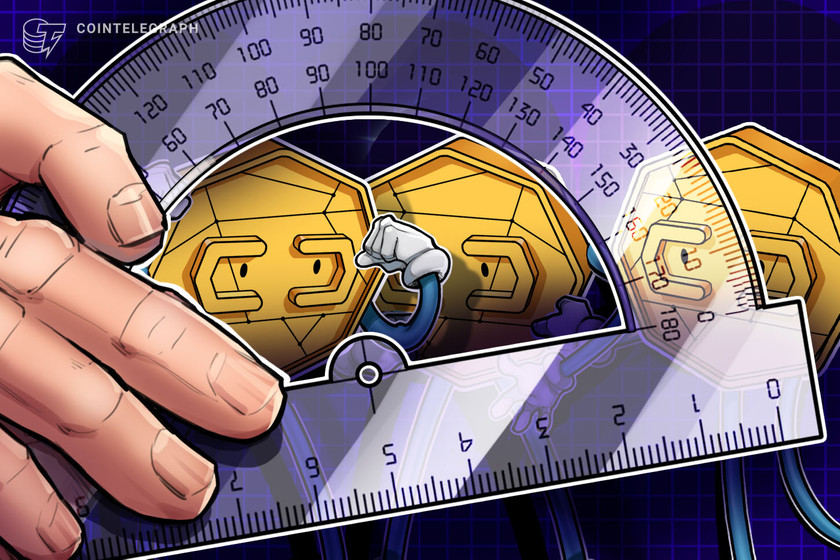Bitcoin price sets up for an explosive move as ADA, XLM, AAVE and CFX turn bullish


BTC’s tight trading range hints at an eventual breakout, and ADA, XLM, AAVE and CFX could follow.
The long weekend has not produced any fireworks in Bitcoin (BTC) price, which continues to trade inside an ever-narrowing range. Bitcoin is on track to form a third consecutive Doji candlestick pattern on the weekly chart. This suggests that the Bitcoin bulls and the bears are not clear about the next directional move.
It is not only Bitcoin that is stuck inside a range. On April 7, Jurrien Timmer, director of global macro at asset manager Fidelity Investments, tweeted that the S&P 500 Index had been stuck inside a range for the past nine months and a breakout was due “sooner or later.”


Bitcoin’s failure to break above the $30,000 level has attracted profit-booking in several altcoins but a few have witnessed shallow pullbacks. This indicates that traders are holding on to their positions expecting a move higher.
Let’s study the charts of select altcoins that may turn up and start an uptrend if Bitcoin breaks out to the upside. What are the resistance levels above which these five cryptocurrencies turn bullish?
Bitcoin price analysis
Bitcoin has been trading inside a tight range for the past two days, indicating indecision among the bulls and the bears. Usually, tight ranges are followed by an expansion in volatility.


The 20-day exponential moving average ($27,500) is flattening out and the relative strength index (RSI) has gradually been slipping toward the center. This suggests a balance between supply and demand.
If the price tumbles below the 20-day EMA, several short-term stop losses may be triggered and the BTC/USDT pair may dive to the breakout level of $25,250.
Conversely, if the price rebounds off the 20-day EMA with strength, it will suggest that the sentiment remains positive and traders are buying the dips. A rally above $29,200 could enhance the prospects of a rally to $30,000 and subsequently to $32,500.


The 20-EMA is flattening out on the four-hour chart and the RSI is just below the midpoint. This does not give a clear advantage either to the bulls or the bears. This uncertainty is unlikely to continue for long, and a directional move could soon start. However, it is difficult to predict the direction of the breakout.
Therefore, it is better to wait for the breakout to happen before establishing directional bets. The important level to watch on the upside is $29,200 and on the downside is $26,500. A breach of either level could start a short-term trending move.
Cardano price analysis
The bulls are not allowing Cardano (ADA) to dip below the 20-day EMA ($0.37), indicating demand at lower levels.


The upsloping 20-day EMA and the RSI in the positive area suggest that the path of least resistance is to the upside. The ADA/USDT pair could first rise to the neckline of the inverse head-and-shoulders pattern. A break and close above this resistance will signal a potential trend change. The pair could then rally toward the pattern target of $0.60.
If bears want to prevent the up-move, they will have to quickly yank the price back below the 20-day EMA. The pair may then drop to the 200-day simple moving average ($0.35) and later to $0.30.


The four-hour chart shows that the bulls have pushed the price above the 20-EMA and will next try to overcome the barrier at the downtrend line. If they do that, it will suggest that the pullback may be over. The pair may then climb to the neckline where the bears are expected to mount a strong defense.
Contrarily, if the price faces rejection at the downtrend line, it will suggest that bears are active at higher levels. The selling could accelerate below $0.37 and the pair may plunge to the 200-SMA.
Stellar price analysis
Stellar (XLM) turned down from the overhead resistance of $0.12 and the price is nearing the 20-day EMA ($0.10). The bulls are likely to buy the dips to the 20-day EMA.


If the price rebounds off the 20-day EMA, the bulls will again try to clear the overhead hurdle. If they succeed, the XLM/USDT pair will complete a bullish rounding bottom pattern. That could signal the start of a new up-move. The pair may first rally to $0.15 and thereafter march toward the pattern target of $0.17.
Contrary to this assumption, if the price turns down and breaks below the 20-day EMA, it will suggest that bulls are losing their grip. The pair may then drop to the 200-day SMA ($0.09). This is a make-or-break level for the bulls because if it cracks, the pair may plummet to $0.07.


The four-hour chart shows that the pair is correcting inside a falling wedge pattern. The price has bounced off the support line and the bulls will next attempt to propel the pair above the wedge. If they manage to do that, the pair could rally to $0.11 and subsequently to $0.12.
On the other hand, if the price turns down and plummets below the support line, it will suggest that the selling has intensified. There is a small support at $0.10 but if that cracks, the decline could extend to the 200-SMA.
Related: SushiSwap approval bug leads to $3.3 million exploit
Aave price analysis
Aave (AAVE) has turned down from the overhead resistance of $82, indicating that the bears are fiercely protecting this level. They have pulled the price below the immediate support at the 20-day EMA ($75).


The AAVE/USDT pair could next slip to the 200-day SMA ($73), which is close to the uptrend line. Buyers are likely to defend this level with vigor. If the price rebounds off the uptrend line and breaks above the 20-day EMA, the pair could reach $82.
If bulls overcome this barrier, the pair will complete an ascending triangle pattern. This setup has a target objective of $100. This bullish view will invalidate if the price continues lower and breaks below the uptrend line. The pair may then slide to $68 and later to $64.


The bears have pulled the price to the 200-SMA on the four-hour chart. The 20-EMA has started to turn down and the RSI is in the negative territory, indicating that bears have the upper hand.
If the 200-SMA gives way, the pair could decline further to the uptrend line. This is an important level for the bulls to defend because a break below it will further strengthen the bears.
On the upside, a break above the 20-EMA will be the first sign that the bulls are making a comeback. The pair may then rise to the overhead resistance at $82.
CFX price analysis
Conflux (CFX) has been in a corrective phase for the past few days but a minor positive is that the bulls are trying to defend the 20-day EMA ($0.36).


If the price rebounds off the current level, the CFX/USDT pair could reach the downtrend line. This is an important level for the bears to guard because a break above it could open the doors for a possible rally to $0.44 and then $0.49.
Conversely, if the price plunges and sustains below the 20-day EMA, it will suggest that the bulls may be rushing to the exit. That could attract further selling, pulling the price toward the next support at $0.30. The bulls are expected to buy the dips to this level.


The four-hour chart shows that the bears are trying to keep the price below the 20-EMA. That could pull the pair to the 200-SMA, which is likely to act as a major support.
If the price rebounds off this level, the bulls will again try to drive the price to the downtrend line. This is the key level to keep an eye on because a break above it will signal that bulls are back in the game.
On the downside, a break and close below the $0.30 support could attract further selling, sinking the price to $0.25.
The views, thoughts and opinions expressed here are the authors’ alone and do not necessarily reflect or represent the views and opinions of Cointelegraph.
This article does not contain investment advice or recommendations. Every investment and trading move involves risk, and readers should conduct their own research when making a decision.





































